Top Rankings
Raleigh Charter High School District ranks among the top 20% of public school district in North Carolina for:
Category
Attribute
Overall Rank
Highest overall rank (Top 1%)
Math Proficiency
Highest math proficiency (Top 1%)
Reading/Language Arts Proficiency
Highest reading/language arts proficiency (Top 1%)
Science Proficiency
Highest science proficiency (Top 5%)
Graduation Rate
Highest graduation rate (Top 5%)
Student Attention
Lowest student:teacher ratio (Top 1%)
For the 2025 school year, there is 1 public school serving 560 students in Raleigh Charter High School District. This district's average testing ranking is 10/10, which is in the top 1% of public schools in North Carolina.
Public School in Raleigh Charter High School District have an average math proficiency score of 92% (versus the North Carolina public school average of 51%), and reading proficiency score of 95% (versus the 50% statewide average).
Minority enrollment is 57% of the student body (majority Asian), which is equal to the North Carolina public school average of 57% (majority Black and Hispanic).
Overview
This School District
This State (NC)
# Schools
1 School
2,764 Schools
# Students
560 Students
1,547,014 Students
# Teachers
44 Teachers
100,085 Teachers
Student : Teacher Ratio
13:1
13:1
District Rank
Raleigh Charter High School District, which is ranked within the top 1% of all 320 school districts in North Carolina (based off of combined math and reading proficiency testing data) for the 2021-2022 school year.
The school district's graduation rate of 95% has stayed relatively flat over five school years.
Overall District Rank
#3 out of 325 school districts
(Top 1%)
(Top 1%)
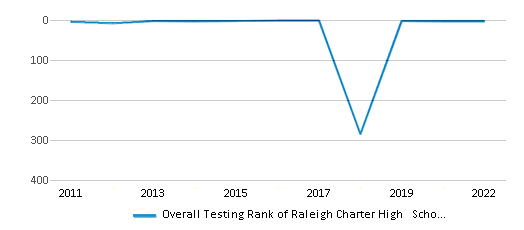
Math Test Scores (% Proficient)
90-94%
51%
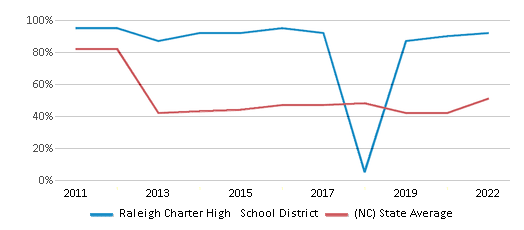
Reading/Language Arts Test Scores (% Proficient)
≥95%
50%
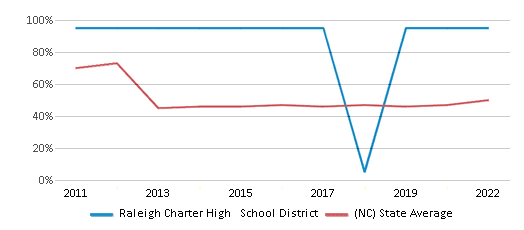
Science Test Scores (% Proficient)
≥90%
63%
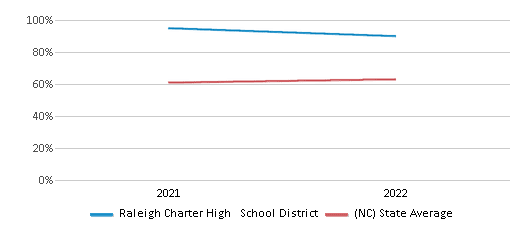
Graduation Rate
≥95%
86%
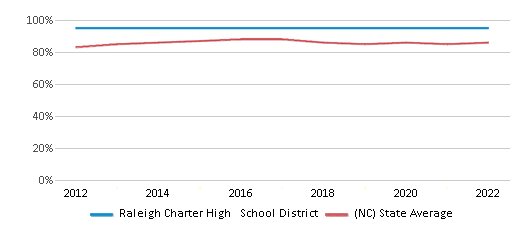
Students by Ethnicity:
Diversity Score
0.68
0.71
# American Indian Students
1 Student
16,971 Students
% American Indian Students
n/a
1%
# Asian Students
204 Students
65,132 Students
% Asian Students
37%
4%
# Hispanic Students
45 Students
326,941 Students
% Hispanic Students
8%
21%
# Black Students
38 Students
380,120 Students
% Black Students
7%
25%
# White Students
240 Students
665,292 Students
% White Students
43%
43%
# Hawaiian Students
2 Students
2,147 Students
% Hawaiian Students
n/a
n/a
# Two or more races Students
30 Students
92,182 Students
% of Two or more races Students
5%
6%
Students by Grade:
# Students in PK Grade:
-
23,648
# Students in K Grade:
-
110,403
# Students in 1st Grade:
-
114,331
# Students in 2nd Grade:
-
118,121
# Students in 3rd Grade:
-
111,941
# Students in 4th Grade:
-
114,493
# Students in 5th Grade:
-
115,565
# Students in 6th Grade:
-
116,023
# Students in 7th Grade:
-
116,793
# Students in 8th Grade:
-
119,029
# Students in 9th Grade:
147
137,977
# Students in 10th Grade:
143
126,349
# Students in 11th Grade:
132
117,582
# Students in 12th Grade:
138
104,759
# Ungraded Students:
-
-
District Revenue and Spending
The revenue/student of $4,030 in this school district is less than the state median of $11,187. The school district revenue/student has stayed relatively flat over four school years.
The school district's spending/student of $8,727 is less than the state median of $11,612. The school district spending/student has stayed relatively flat over four school years.
Total Revenue
$2 MM
$17,307 MM

Spending
$5 MM
$17,964 MM

Revenue / Student
$4,030
$11,187
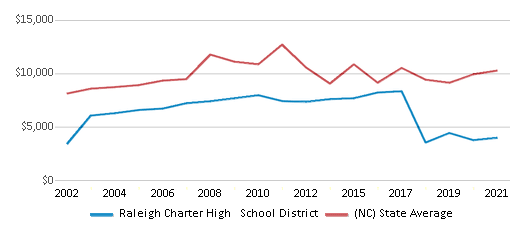
Spending / Student
$8,727
$11,612

Best Raleigh Charter High School District Public Schools (2025)
School
(Math and Reading Proficiency)
(Math and Reading Proficiency)
Location
Grades
Students
Rank: #11.
Raleigh Charter High School
Charter School
(Math: 90-94% | Reading: ≥95%)
Rank:
Rank:
10/
Top 1%10
1307 Glenwood Avenue
Raleigh, NC 27605
(919) 715-1155
Raleigh, NC 27605
(919) 715-1155
Grades: 9-12
| 560 students
Frequently Asked Questions
How many schools belong to Raleigh Charter High School District?
Raleigh Charter High School District manages 1 public schools serving 560 students.
What is the rank of Raleigh Charter High School District?
Raleigh Charter High School District is ranked #3 out of 320 school districts in North Carolina (top 1%) based off of combined math and reading proficiency testing data for the 2021-2022 school year. This district ranks in the top 20% of North Carolina school districts for: Highest overall rank (Top 1%), Highest math proficiency (Top 1%), Highest reading/language arts proficiency (Top 1%), Highest science proficiency (Top 5%), Highest graduation rate (Top 5%) and Lowest student:teacher ratio (Top 1%)
What is the racial composition of students in Raleigh Charter High School District?
43% of Raleigh Charter High School District students are White, 37% of students are Asian, 8% of students are Hispanic, 7% of students are Black, and 5% of students are Two or more races.
What is the student/teacher ratio of Raleigh Charter High School District?
Raleigh Charter High School District has a student/teacher ratio of 13:1, which is lower than the North Carolina state average of 15:1.
What is Raleigh Charter High School District's spending/student ratio?
The school district's spending/student of $8,727 is less than the state median of $11,612. The school district spending/student has stayed relatively flat over four school years.
Recent Articles

Year-Round Or Traditional Schedule?
Which is more appropriate for your child? A year-round attendance schedule or traditional schedule? We look at the pros and cons.

Why You Should Encourage Your Child to Join a Sports Team
Participating in team sports has a great many benefits for children, there is no doubt. In this article you will learn what those benefits are.

White Students are Now the Minority in U.S. Public Schools
Increasing birth rates among immigrant families from Asia and Central and South America, combined with lower birth rates among white families, means that for the first time in history, public school students in the United States are majority-minority. This shift in demographics poses difficulties for schools as they work to accommodate children of varying language abilities and socio-economic backgrounds.





